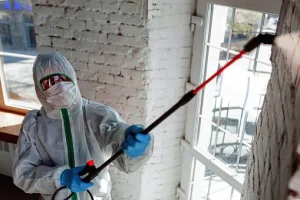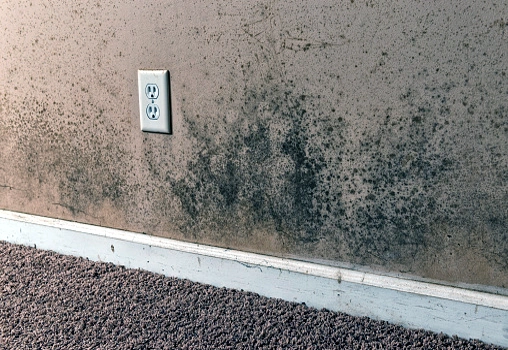Mold and mildew are two fungi that thrive well in moist environments. They are commonly found on household surfaces and items. You can find them in shower walls, crawl spaces, ceilings, clothing, leather items, and in damp areas.
So what’s the difference between mold and mildew? Mold and mildew have different harmful effects on your health and your home.
Mold and mildew thrive in moist environments. To prevent mildew and mold growth, keep your home dry at all times. Moisture creates an ideal environment for these fungi to thrive.
What are Mold and Mold Spores?
Mold is a surface fungus that thrives in moist environments. It can be green, red, black, or blue in color. It frequently appears raised, slimy, and fuzzy. Mold spores procreate molds. These spores land on a surface and cause mold to grow. Mold grows when mold spores fall into a damp environment with suitable conditions.
What are Mildew and Mold Growth?
Mildew is a type of fungi that grows in organic materials such as wood, clothes, plants, and others. Its appearance is yellow, gray, or white organic materials such as wood, clothes, plants, and others. Its appearance is yellow, gray, or white. Downy mildew is yellow in the early stages and turns brown later on. When spores land on the surface mildew grows first on the flat surface and eventually it can develop into molds. Mold and mildew spread from one area to another by releasing tiny spores.
At first, mildew has a white color, but as time continues, it changes its color to white. It generally appears flat and sometimes looks dry. Its texture is fluffy and powdery. Mildew can be the early stages of the growth of some molds. Mold growth results when mold spores spread to a large surface, and as a result, more mold grows, covering a large area. Mold is difficult to detect because it grows inside damp surfaces.
What Is the Distinction Between Mold and Mildew?
Mold and mildew have some very unique characteristics that will help you understand the difference between mold and mildew.
Their Appearance
Both Mold and mildew are distinguished by their color. Mold and mildew are easily distinguished by their appearance. Mold appears to have been raised. Its texture can appear slimy, fuzzy, or hairy at times. They can be green, black, or blue in color.
Mildew appears to be a flat surface. Mildew has a powdery appearance and can start out white before changing to brown, yellow, white, or grey.
Places They Grow
Mold and mildew both thrive in moist environments, but each has a preferred growing environment. Mold, for example, is most commonly found on ceiling tiles, paper products, and wood products. Mold can also be found in foods.
Mold grows on moist flat surfaces like plant leaves, whereas mildew can grow on any organic surface. Molds and mildew are commonly found on the tops of flat surfaces, whereas mildew grows deeper into the surfaces. Mildew removal is thus simpler than mold removal. To remove mildew, use a spray bottle filled with a bleach solution.
Effects They bring to Your Home
Mold and mildew growth both cause harmful damage to your home’s surfaces and detract from its aesthetic appeal.
Mildew attacks the tops of flat surfaces, whereas mold penetrates and breaks down the surfaces, causing complete damage. Mildew may require only minor repairs.
Difference In Scent
The smell is another way to distinguish mildew from mold. Though they both have the same smell, there is a difference in intensity. Mildew has a milder, mustier odor that is frequently compared to damp socks.
Mold has a stronger, more pungent, musty odor. Mold continues to grow and produces microbial volatile organic compounds, which emit a foul odor.
Health Risks
Mold and mildew can have harmful effects on both humans and animals. However, mildew has milder effects, since inhaling mildew spores can lead to a coughing fit and breathing difficulties mildew spores can lead to coughing fit and breathing difficulties. People who have allergies, asthma, and respiratory issues may experience more severe symptoms, while others may experience little to no severe reactions.
Mold exposure can cause health problems such as allergies, asthma, and respiratory problems. Some of the symptoms are:
- Minor respiratory problems such as coughs.
- Irritation and itchy eyes.
- Wheezing.
- Skin irritation.
- Runny nose.
Black mold is a toxic mold that leads to serious health issues, it can cause serious respiratory effects and may even result in death.

Removal methods for Mold and Mildew
You can use a scrub brush to remove mildew from surfaces. Make sure you wear protective gear when getting rid of this fungus. Soapy water can clean mold and mildew that are on surfaces, though it cannot easily get rid of mold fungi that have penetrated moist surfaces. Also, bleach solutions cannot get rid of mold growth completely.
Get rid of these fungi as soon as possible to prevent mold from spreading to other surfaces. Vinegar has antibacterial properties and can kill mold. This will only solve the mold problem and prevent mold growth, depending on how much mold has spread.
Are there benefits?
Not all molds are harmful; in fact, some molds are beneficial. Penicillium, for example, is a mold that produces penicillin, which is then extracted and used as an antibiotic.
Furthermore, because not all molds produce toxins, they are considered safe. Mold will also hasten the decomposition of organic matter like leaves and dead trees.
This, however, should not be used to dismiss the significance of mold removal. Because you and many other people may not be able to identify the type of mold in your home, it is critical that you remove it completely.
Are You In Need of Mold Removal and Mold Remediation Services?
If you reside in West Palm Beach, Florida, and you are in need of the services above, Titan Restoration Construction has got you covered. Our team has the knowledge and proper protective gear to remove mold and moisture so that the mold does not grow again. If you tried using a bleach solution or soapy water and they were ineffective, it is time to call in our experts.
No matter how much mold has affected your home, our technicians can help you in the removal process. You can call us at (561) 763-4978 to schedule an appointment with us today. You can also visit our offices located in West Palm Beach, Florida, to inquire more about the services we offer.


0 Comments